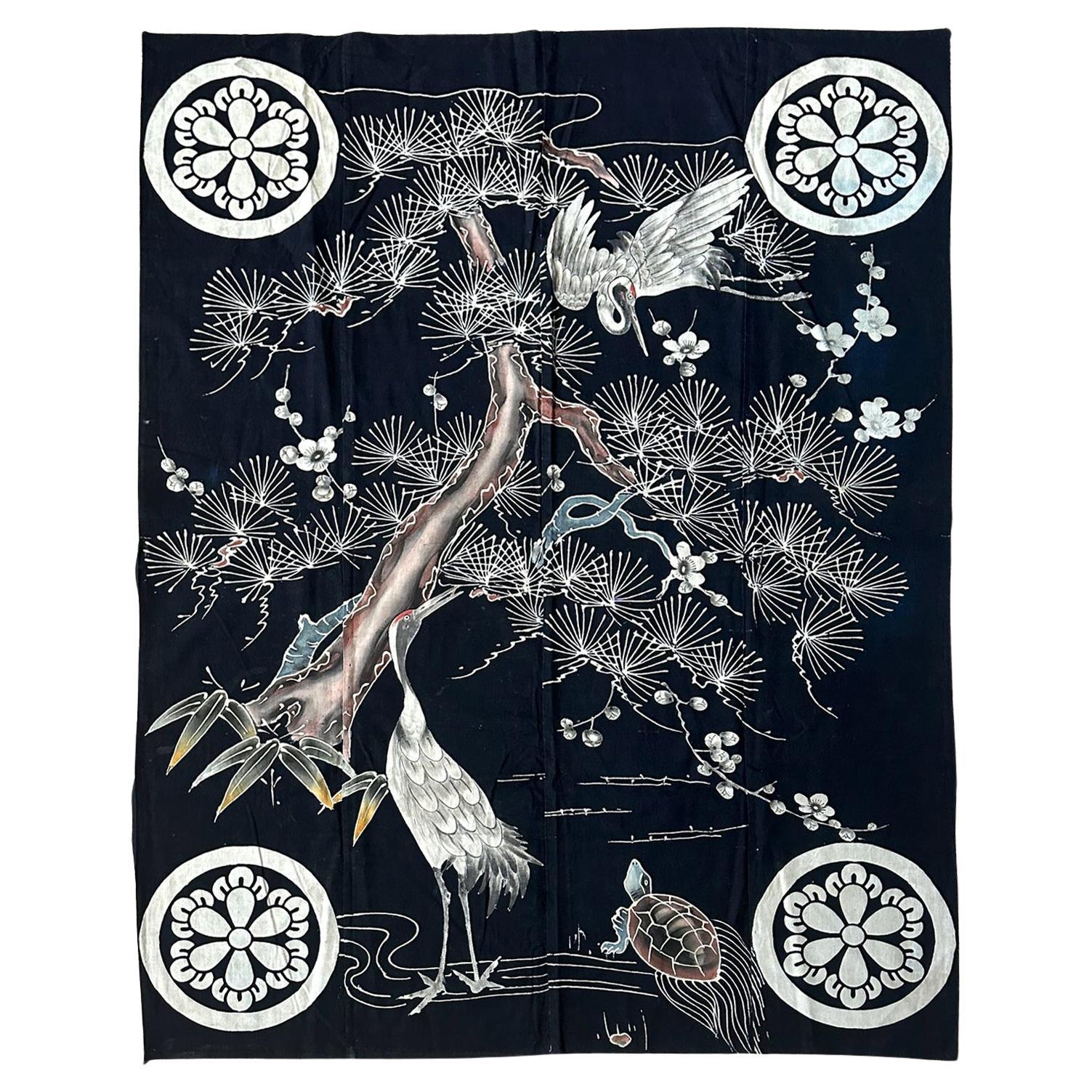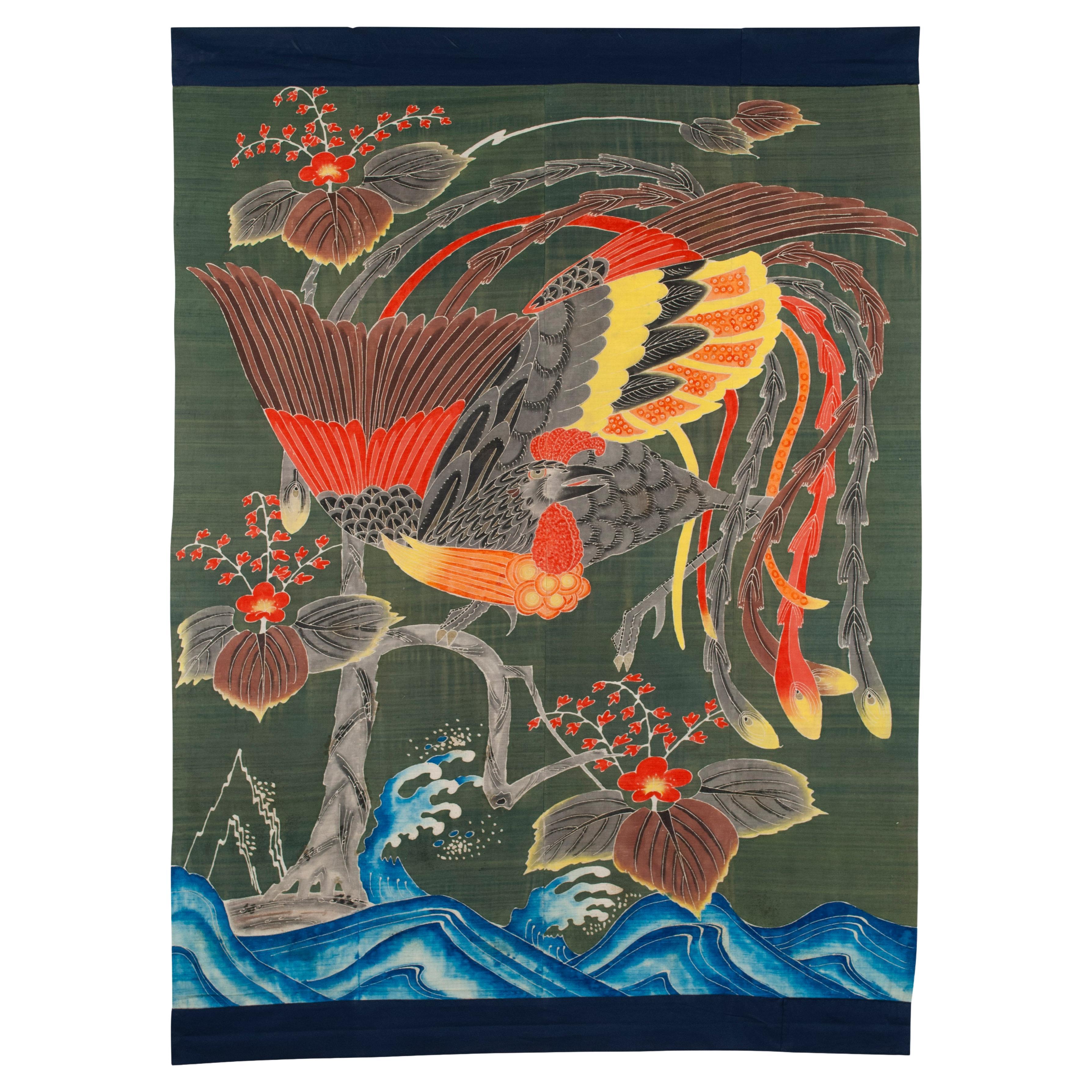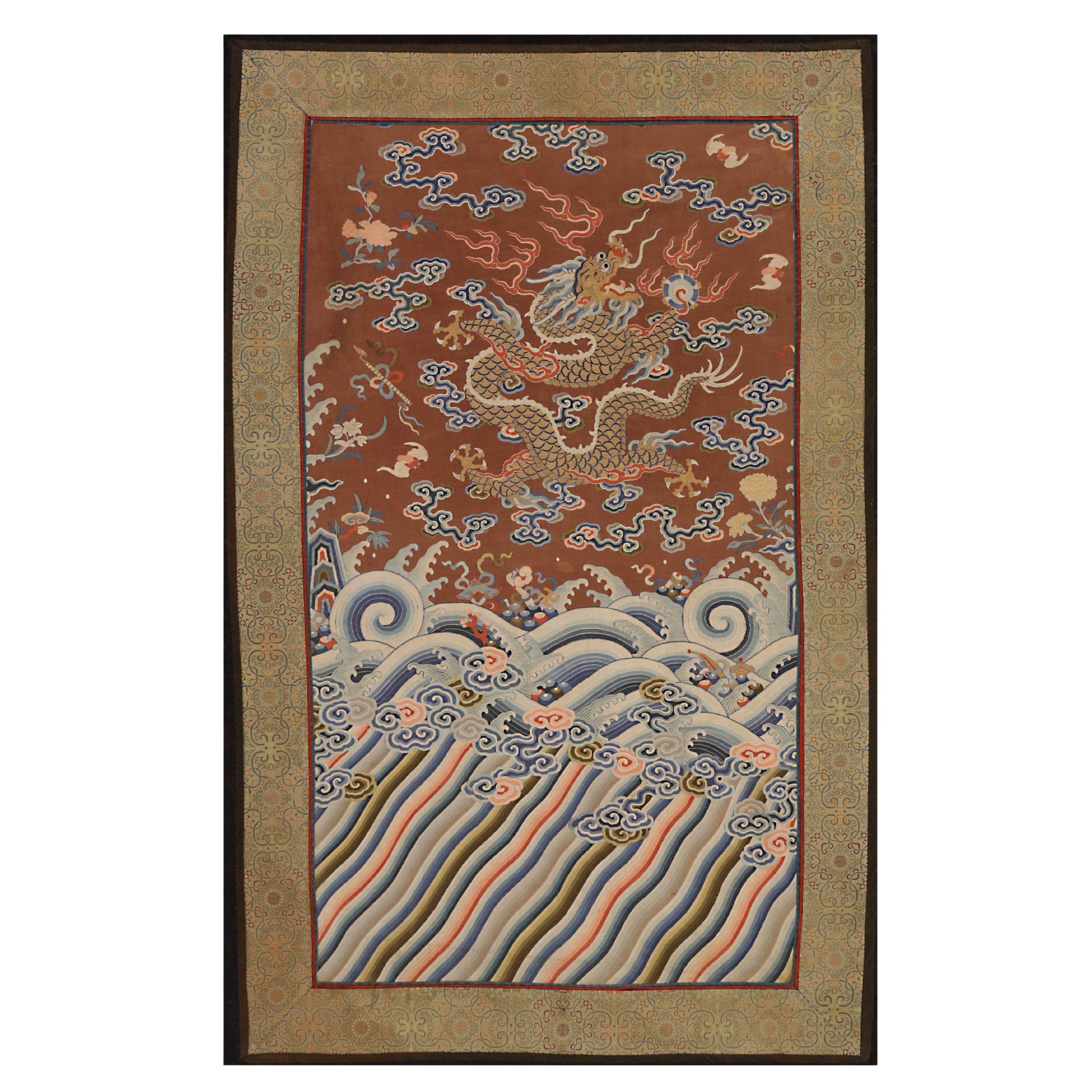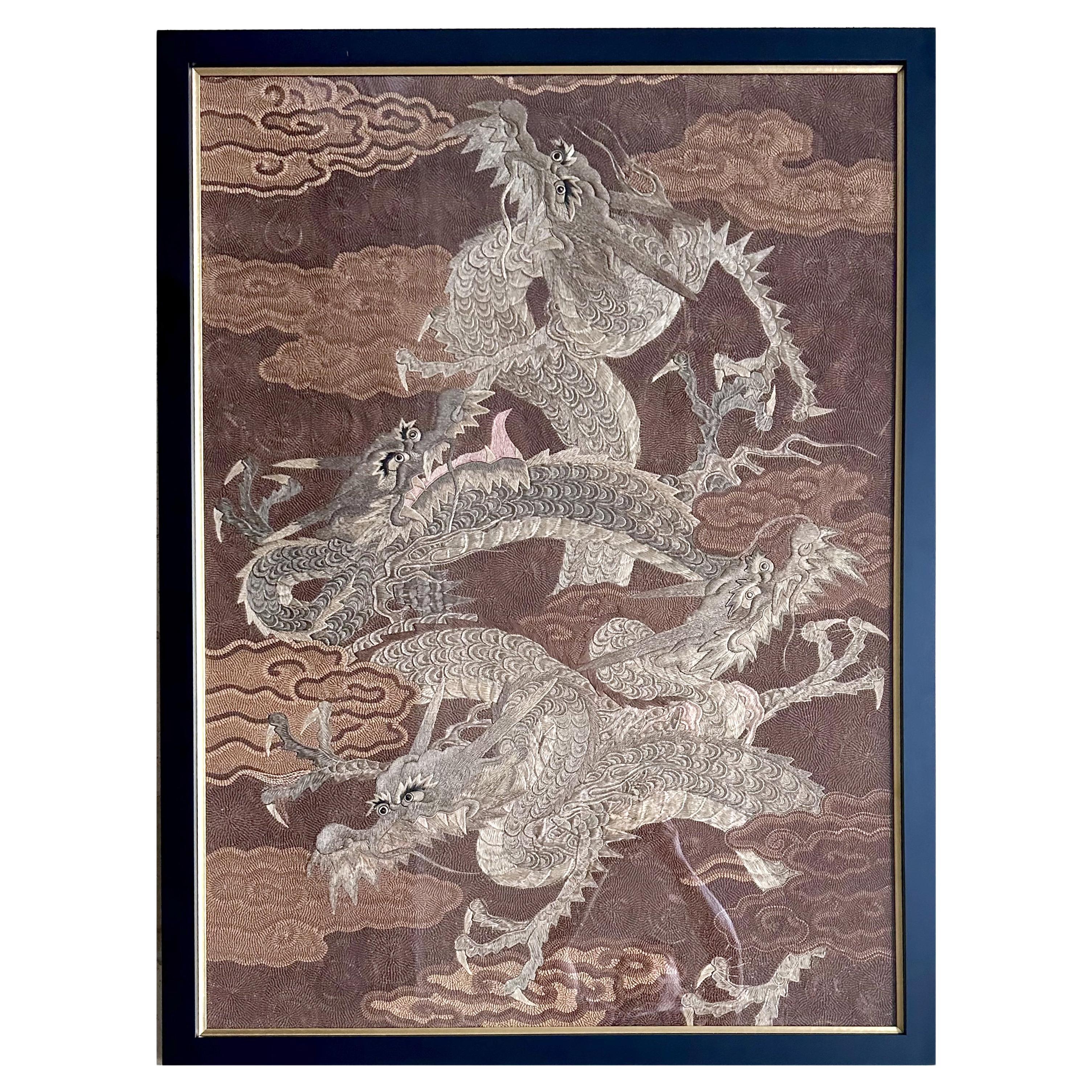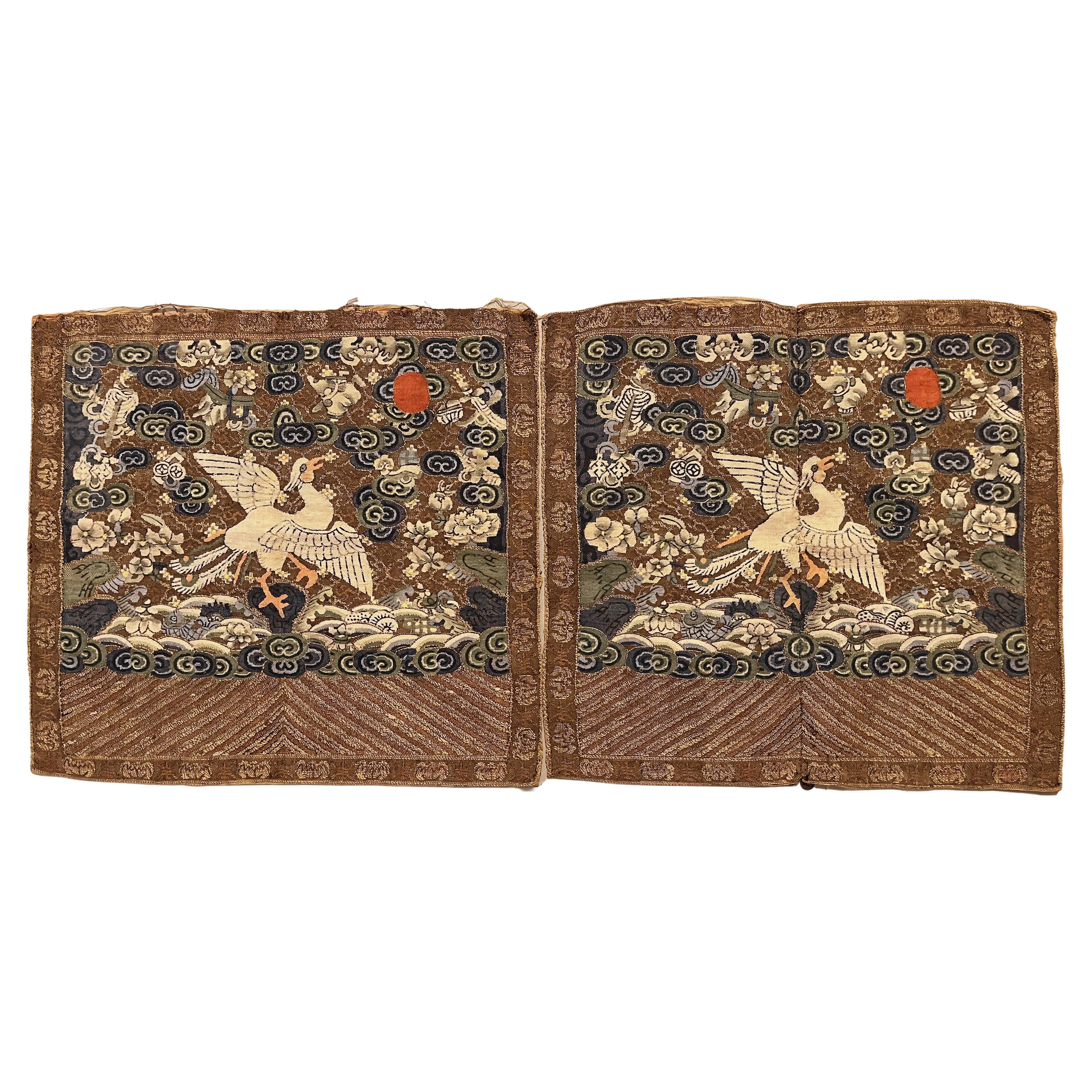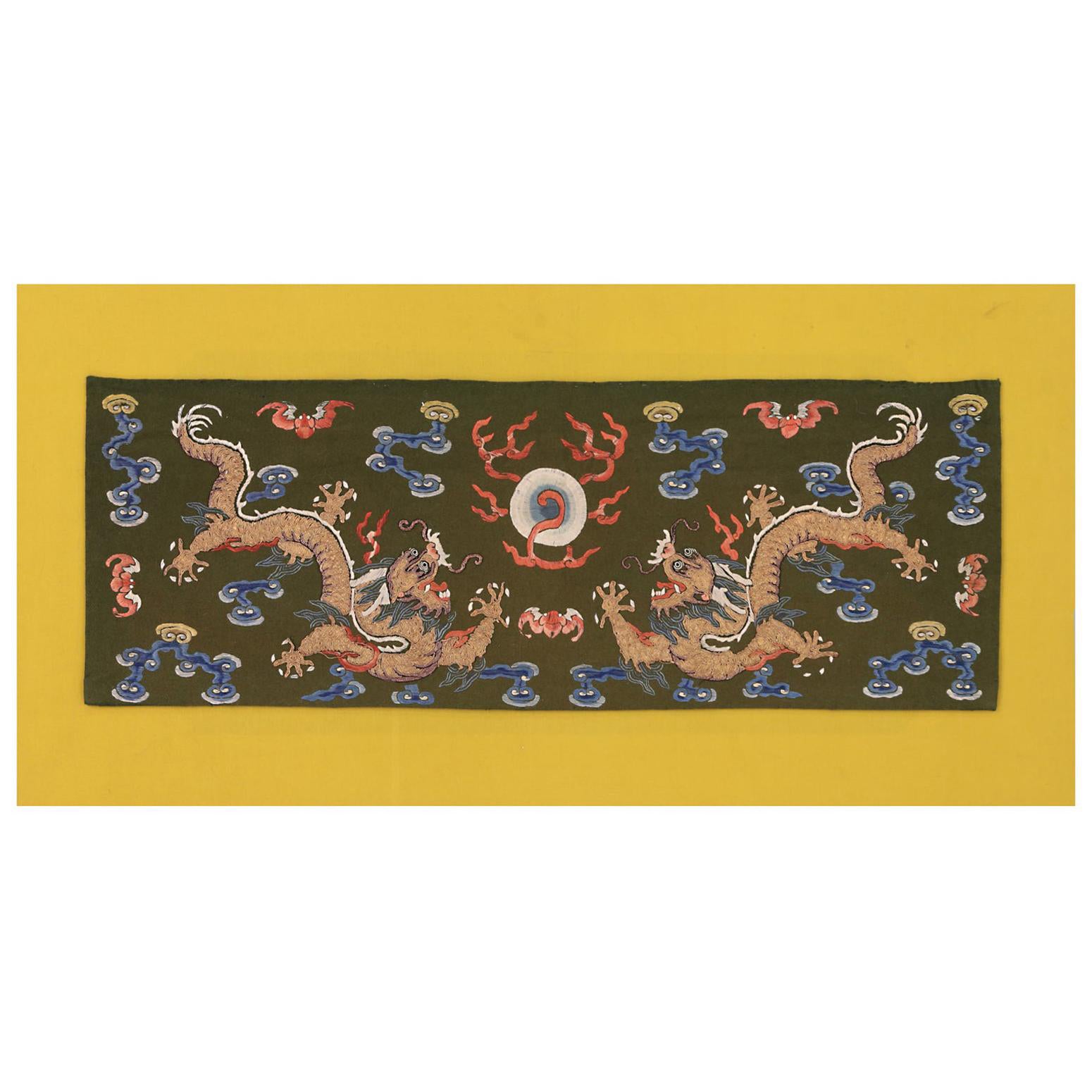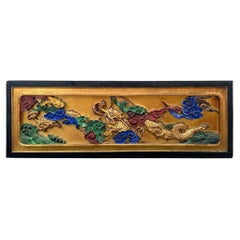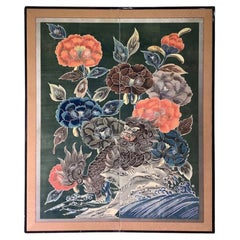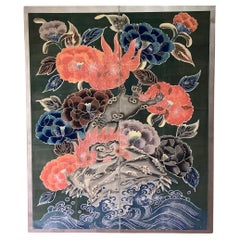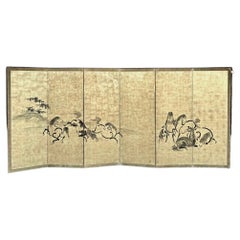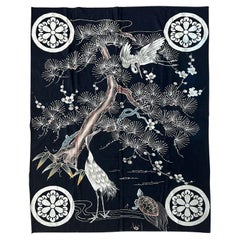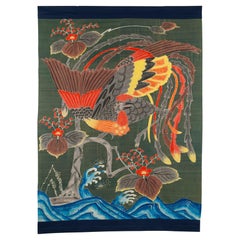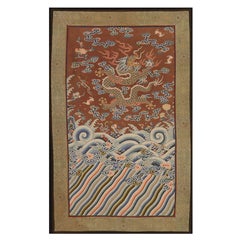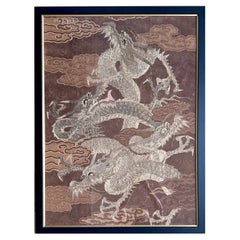Items Similar to Meiji Period Golden Dragon Zabuton Covers by Tanaka Rishichi
Want more images or videos?
Request additional images or videos from the seller
1 of 13
Meiji Period Golden Dragon Zabuton Covers by Tanaka Rishichi
$330
£250.40
€286.31
CA$460.92
A$512.48
CHF 267.59
MX$6,238.14
NOK 3,414.32
SEK 3,199.06
DKK 2,136.75
Shipping
Retrieving quote...The 1stDibs Promise:
Authenticity Guarantee,
Money-Back Guarantee,
24-Hour Cancellation
About the Item
The unique batik zabuton covers are adorned with golden dragons and are believed to have been originally ordered for a temple. The cushion covers were made under the Tanaka Rishichi art resurrection project. He was a highly significant figure in the world of Japanese art, particularly in the realm of traditional textile art and embroidery crafts. Born in 1847 and died in 1902, Tanaka san dedicated his life to the promotion and resurrection of these ancient Japanese art forms.
During the Meiji period in Japan, the political turmoil and wars nearly caused these crafts to be lost. However, Tanaka Rishichi (1847-1902) worked tirelessly to keep them alive by establishing a unique association of Japanese craftsmen and promoting their art and his efforts were successful in revitalizing these traditional crafts that were on the verge of extinction.
Tanaka Rishichi is highly respected and recognized for his contributions in the field of Japanese art. His dedication and passion for these crafts were such that he became the exclusive supplier of textiles to the Imperial House of Meiji.
Through his efforts, the world can now witness the unique beauty and intricacy of ancient Japanese art. Tanaka Rishichi's influence can still be felt today, as his legacy lives on through the traditional textile and embroidery crafts that are still being practiced and celebrated in Japan.
The covers measure 56x112 cm. These covers are a testament to the dedication and skill of these artisans, and are truly unique pieces of art.
- Dimensions:Height: 0.04 in (1 mm)Width: 44.1 in (112 cm)Depth: 22.05 in (56 cm)
- Style:Meiji (Of the Period)
- Materials and Techniques:
- Place of Origin:
- Period:
- Date of Manufacture:Unknown
- Condition:
- Seller Location:Fukuoka, JP
- Reference Number:1stDibs: LU8121234160612
About the Seller
5.0
Vetted Professional Seller
Every seller passes strict standards for authenticity and reliability
Established in 1998
1stDibs seller since 2023
57 sales on 1stDibs
Typical response time: <1 hour
- ShippingRetrieving quote...Shipping from: Fukuoka, Japan
- Return Policy
Authenticity Guarantee
In the unlikely event there’s an issue with an item’s authenticity, contact us within 1 year for a full refund. DetailsMoney-Back Guarantee
If your item is not as described, is damaged in transit, or does not arrive, contact us within 7 days for a full refund. Details24-Hour Cancellation
You have a 24-hour grace period in which to reconsider your purchase, with no questions asked.Vetted Professional Sellers
Our world-class sellers must adhere to strict standards for service and quality, maintaining the integrity of our listings.Price-Match Guarantee
If you find that a seller listed the same item for a lower price elsewhere, we’ll match it.Trusted Global Delivery
Our best-in-class carrier network provides specialized shipping options worldwide, including custom delivery.More From This Seller
View AllMeiji Temple Dragon Panels
Located in Fukuoka, JP
Magnificent Meiji-era temple panel is traditionally placed above the entrance, gracing the space with spiritual protection and aesthetic beauty. Each panel vividly depicts a dragon, ...
Category
Antique Late 19th Century Japanese Meiji Sculptures and Carvings
Materials
Gold Leaf
Late Edo period Tsutsugaki 筒描 Auspicious Shishi Batik Screen
Located in Fukuoka, JP
Auspicious Shishi Batik Screen
Period: Late Edo
Size: 145x173 cm (57x68 inches)
SKU: PTA62
Step into the mythical world of late Edo Japan with our radiant batik screen depicting the...
Category
Antique 19th Century Japanese Edo Paintings and Screens
Materials
Cotton, Wood
Late Edo period Tsutsugaki 筒描 Auspicious Shishi Batik Screen
Located in Fukuoka, JP
Auspicious Shishi Batik Screen
Period: Late Edo
Size: 145x173 cm (57x68 inches)
SKU: PTA62
Step into the mythical world of late Edo Japan with our radiant batik screen depicting the...
Category
Antique 19th Century Japanese Edo Paintings and Screens
Materials
Cotton, Wood
Elegant Horse Screen. In style of Kano Tanshin
By Kano Tanshin
Located in Fukuoka, JP
Ink on gold.
This continuation of equine grace unfolds across a stunning gold-leaf backdrop, capturing the essence of nobility that horses represent in Japanese lore.
The screen de...
Category
Antique Late 18th Century Japanese Edo Paintings and Screens
Materials
Gold Leaf
Edo Period Kyoto Screen (2/2)
Located in Fukuoka, JP
Edo Period Kyoto Screen
Period: Edo period
Size: 343 x 176 cm (134.6 x 69 inches)
SKU: RJ69/2
This stunning Edo period screen depicts typical scenes of...
Category
Antique 18th Century Japanese Edo Paintings and Screens
Materials
Silk, Wood, Paper
Lavish 19th Century Maruyama School Peacock Screen
Located in Fukuoka, JP
Lavish 19th Century Maruyama School Peacock Screen
Period: 19th Century
Size: 360 x 173 cm (141.7 x 68.1 inches)
SKU: PF12
Behold the grandeur of the ...
Category
Antique 19th Century Japanese Edo Paintings and Screens
Materials
Wood, Paper
You May Also Like
Large Japanese Textile Futon Cover with Resist Yuzen Dye
Located in Atlanta, GA
A large unframed Japanese textile art circa late early 20th century toward the end of the Meiji period. Seamed together from four vertical sections of cotton in deep indigo color, th...
Category
Early 20th Century Japanese Meiji Textiles
Materials
Cotton
Rare Antique Formal Japanese Silk Tsutsugaki Futon Cover
Located in Point Richmond, CA
Rare Antique Formal Japanese Silk Tsutsugaki Futon Cover
An exceptional example of tsutsugaki from the late Meiji period. The abstract rendering of the auspicious phoenix and paulo...
Category
Antique Late 19th Century Japanese Meiji Tribal Art
Materials
Cotton, Silk
Imperial Five-Clawed Dragon Chinese Textile 'Silk & Metal', 18th Century
Located in Ferrara, IT
This is an 18th-century imperial silk Chinese textile that measures 79 x 47CM in size. This rare example has been preserved in excellent condition and has retained its dramatic satur...
Category
Antique 18th Century Chinese Other Textiles
Materials
Silk
Framed Japanese Embroidery Dragon Tapestry Meiji Period
Located in Atlanta, GA
A striking Japanese embroidery tapestry circa 1890s Meiji period presented in a gilt wood frame under glaze. The design features four dragons coiling and slithering in the clouds. The most auspicious mythological creature, dragon was a very popular motif in Japanese textile art. Viewing this particular piece, one is struck by the superb craftsmanship with the profuse use of silver threads in satin stitches and complex chain stich coiling that create the background. The slight relief technique was also used on parts of the dragon heads, rendering the piece a strong sense of dimension and motion. The textile itself measures about 32.5"x46".
Japanese Meiji textiles were widely exhibited in the west during turn of the 20th century at the international exposition. It was used to showcase the Japanese aesthetics with the techniques at their pinnacle. These expositions solidified the country's images overseas and felled the Japanese craze in the west, which turned out to be a long-lasting influence on the western art. Many pieces were purchased and stayed in the west. As there is no brocade border present, the piece is likely the main part with the central motifs of a larger tapestry and was later framed for display.
For two similar dragon tapestries...
Category
Antique 1890s Japanese Meiji Textiles
Materials
Textile, Wood
Pair of Qing Dynasty Kesi Imperial Civil Officer Rank Badges
Located in Greenwich, CT
Pair of Qing Dynasty Kesi Imperial civil officer rank badges with pheasant alighting astop a rock emerging from cloud and waves surrounding with auspicious symbols.
Overall in very ...
Category
Antique 19th Century Chinese Qing Textiles
Materials
Silk
Pair of Five Clawed Dragon Design Silk & Metal Chinese Textile
Located in Ferrara, IT
These unique and magnificent pair of textiles with their distinctive design can fascinate you for a long time. Mythical dragons depicted in these textiles consistently played a signi...
Category
Antique 19th Century Chinese Textiles
Materials
Metallic Thread
More Ways To Browse
Ancient Japanese
Dior Asia
Japanese Cushion
Meiji Dragon
Meiji Figure
Dior Dragon
Dragon Embroidery
Meiji Embroidery
19th Century Japanese Embroidery
Antique Silk Robe
Asian Silk Screen Wall Art
Japanese Obi
Eastern European Textiles
Asian Chinese Silk Embroidered Art
Suzani Screen
19th Century Chinese Embroidery
Japanese Silk Embroidered
Framed Chinese Embroidery
